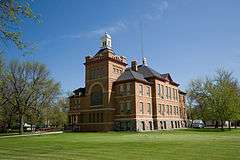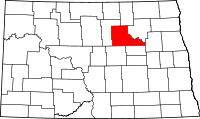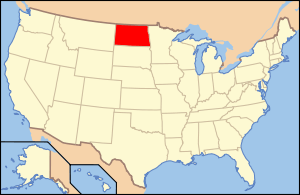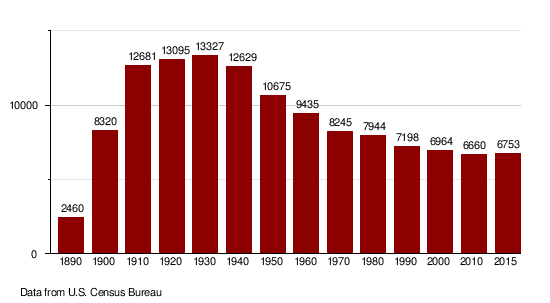Benson County, North Dakota
| Benson County, North Dakota | |
|---|---|
 | |
 Location in the U.S. state of North Dakota | |
 North Dakota's location in the U.S. | |
| Founded | June 4, 1884 |
| Seat | Minnewaukan |
| Largest community | Fort Totten |
| Area | |
| • Total | 1,439 sq mi (3,727 km2) |
| • Land | 1,389 sq mi (3,597 km2) |
| • Water | 51 sq mi (132 km2), 3.5% |
| Population (est.) | |
| • (2015) | 6,753 |
| • Density | 4.8/sq mi (2/km²) |
| Congressional district | At-large |
| Time zone | Central: UTC-6/-5 |
| Website |
www |
Benson County is a county located in the U.S. state of North Dakota. As of the 2010 census, the population was 6,660.[1] Its county seat is Minnewaukan.[2] The county was created by the 1879 territorial legislature and named for B.W. Benson, a Dakota Territory legislator at the time. The county government was first organized on June 4, 1884.[3][4]
Sullys Hill National Game Preserve and much of the Spirit Lake Indian Reservation are located within the county.
Geography
According to the U.S. Census Bureau, the county has a total area of 1,439 square miles (3,730 km2), of which 1,389 square miles (3,600 km2) is land and 51 square miles (130 km2) (3.5%) is water.[5]
Adjacent counties
- Towner County (north)
- Ramsey County (northeast)
- Nelson County (east)
- Eddy County (southeast)
- Wells County (southwest)
- Pierce County (west)
Major highways
 U.S. Highway 2
U.S. Highway 2 U.S. Highway 281
U.S. Highway 281 North Dakota Highway 19
North Dakota Highway 19 North Dakota Highway 20
North Dakota Highway 20 North Dakota Highway 57
North Dakota Highway 57
National protected areas
- Pleasant Lake National Wildlife Refuge
- Silver Lake National Wildlife Refuge (part)
- Sullys Hill National Game Preserve
- Wood Lake National Wildlife Refuge
Demographics
| Historical population | |||
|---|---|---|---|
| Census | Pop. | %± | |
| 1890 | 2,460 | — | |
| 1900 | 8,320 | 238.2% | |
| 1910 | 12,681 | 52.4% | |
| 1920 | 13,095 | 3.3% | |
| 1930 | 13,327 | 1.8% | |
| 1940 | 12,629 | −5.2% | |
| 1950 | 10,675 | −15.5% | |
| 1960 | 9,435 | −11.6% | |
| 1970 | 8,245 | −12.6% | |
| 1980 | 7,944 | −3.7% | |
| 1990 | 7,198 | −9.4% | |
| 2000 | 6,964 | −3.3% | |
| 2010 | 6,660 | −4.4% | |
| Est. 2015 | 6,753 | [6] | 1.4% |
| U.S. Decennial Census[7] 1790-1960[8] 1900-1990[9] 1990-2000[10] 2010-2015[1] | |||
2000 census
As of the census of 2000, there were 6,964 people, 2,328 households, and 1,701 families residing in the county. The population density was 5 people per square mile (2/km²). There were 2,932 housing units at an average density of 2 per square mile (1/km²). The racial makeup of the county was mostly White (50.85%) and Native American (48.05%). In addition, 0.10% are Black/African American, 0.01% are Asian, 0.01% are Pacific Islander, 0.16% are from other races, and 0.82% are from two or more races. 0.79% of the population were Hispanic or Latino of any race. 25.2% were of Norwegian and 14.8% German ancestry.
There were 2,328 households out of which 38.00% had children under the age of 18 living with them, 48.50% were married couples living together, 16.60% had a female householder with no husband present, and 26.90% were non-families. 24.50% of all households were made up of individuals and 12.50% had someone living alone who was 65 years of age or older. The average household size was 2.97 and the average family size was 3.48.
In the county the population was spread out with 36.10% under the age of 18, 7.80% from 18 to 24, 23.30% from 25 to 44, 19.40% from 45 to 64, and 13.50% who were 65 years of age or older. The median age was 31 years. For every 100 females there were 102.10 males. For every 100 females age 18 and over, there were 102.00 males.
The median income for a household in the county was $26,688, and the median income for a family was $31,558. Males had a median income of $23,056 versus $17,862 for females. The per capita income for the county was $11,509. About 24.40% of families and 29.10% of the population were below the poverty line, including 38.90% of those under age 18 and 16.70% of those age 65 or over.
2010 census
As of the 2010 United States Census, there were 6,660 people, 2,233 households, and 1,628 families residing in the county.[11] The population density was 4.8 inhabitants per square mile (1.9/km2). There were 2,950 housing units at an average density of 2.1 per square mile (0.81/km2).[12] The racial makeup of the county was 55.0% American Indian, 43.4% white, 0.2% from other races, and 1.4% from two or more races. Those of Hispanic or Latino origin made up 1.2% of the population.[11] In terms of ancestry, 22.0% were Norwegian, 18.0% were German, 5.0% were Irish, and 0.6% were American.[13]
Of the 2,233 households, 41.3% had children under the age of 18 living with them, 42.3% were married couples living together, 20.6% had a female householder with no husband present, 27.1% were non-families, and 23.2% of all households were made up of individuals. The average household size was 2.98 and the average family size was 3.46. The median age was 31.6 years.[11]
The median income for a household in the county was $30,479 and the median income for a family was $34,597. Males had a median income of $31,729 versus $25,253 for females. The per capita income for the county was $14,545. About 26.1% of families and 35.6% of the population were below the poverty line, including 48.3% of those under age 18 and 16.9% of those age 65 or over.[14]
Population by decade

Communities
Cities
Townships
- Albert
- Arne
- Aurora
- Beaver
- Broe
- Butte Valley
- East Fork
- Eldon
- Esmond
- Hesper
- Impark
- Iowa
- Irvine
- Isabel
- Knox
- Lake Ibsen
- Lallie
- Leeds
- Lohnes
- McClellan
- Minco
- Mission
- Normania
- North Viking
- Oberon
- Pleasant Lake
- Rich Valley
- Riggin
- Rock
- South Viking
- Twin Lake
- Twin Tree
- Warwick
- West Antelope
- West Bay
- Wood Lake
- York
Census-designated place
Other communities
See also
References
- 1 2 "State & County QuickFacts". United States Census Bureau. Retrieved October 31, 2013.
- ↑ "Find a County". National Association of Counties. Archived from the original on 2011-05-31. Retrieved 2011-06-07.
- ↑ "County History". Official Portal for North Dakota State Government. Retrieved 4 May 2011.
- ↑ "Dakota Territory, South Dakota, and North Dakota: Individual County Chronologies". Dakota Territory Atlas of Historical County Boundaries. The Newberry Library. 2006. Retrieved February 2, 2015.
- ↑ "2010 Census Gazetteer Files". United States Census Bureau. August 22, 2012. Retrieved January 27, 2015.
- ↑ "County Totals Dataset: Population, Population Change and Estimated Components of Population Change: April 1, 2010 to July 1, 2015". Retrieved July 2, 2016.
- ↑ "U.S. Decennial Census". United States Census Bureau. Archived from the original on May 11, 2015. Retrieved January 27, 2015.
- ↑ "Historical Census Browser". University of Virginia Library. Retrieved January 27, 2015.
- ↑ Forstall, Richard L., ed. (March 27, 1995). "Population of Counties by Decennial Census: 1900 to 1990". United States Census Bureau. Retrieved January 27, 2015.
- ↑ "Census 2000 PHC-T-4. Ranking Tables for Counties: 1990 and 2000" (PDF). United States Census Bureau. April 2, 2001. Retrieved January 27, 2015.
- 1 2 3 "DP-1 Profile of General Population and Housing Characteristics: 2010 Demographic Profile Data". United States Census Bureau. Retrieved 2016-03-14.
- ↑ "Population, Housing Units, Area, and Density: 2010 - County". United States Census Bureau. Retrieved 2016-03-14.
- ↑ "DP02 SELECTED SOCIAL CHARACTERISTICS IN THE UNITED STATES – 2006-2010 American Community Survey 5-Year Estimates". United States Census Bureau. Retrieved 2016-03-14.
- ↑ "DP03 SELECTED ECONOMIC CHARACTERISTICS – 2006-2010 American Community Survey 5-Year Estimates". United States Census Bureau. Retrieved 2016-03-14.
 |
Towner County | Ramsey County |  | |
| Pierce County | |
Nelson County | ||
| ||||
| | ||||
| Wells County | Eddy County |
Coordinates: 48°04′N 99°22′W / 48.07°N 99.36°W